5 Things to Do in Little Tokyo, California
Never been before? We’ll be your trustee Little Tokyo guide with a day’s worth of fun things to do in Little Tokyo.
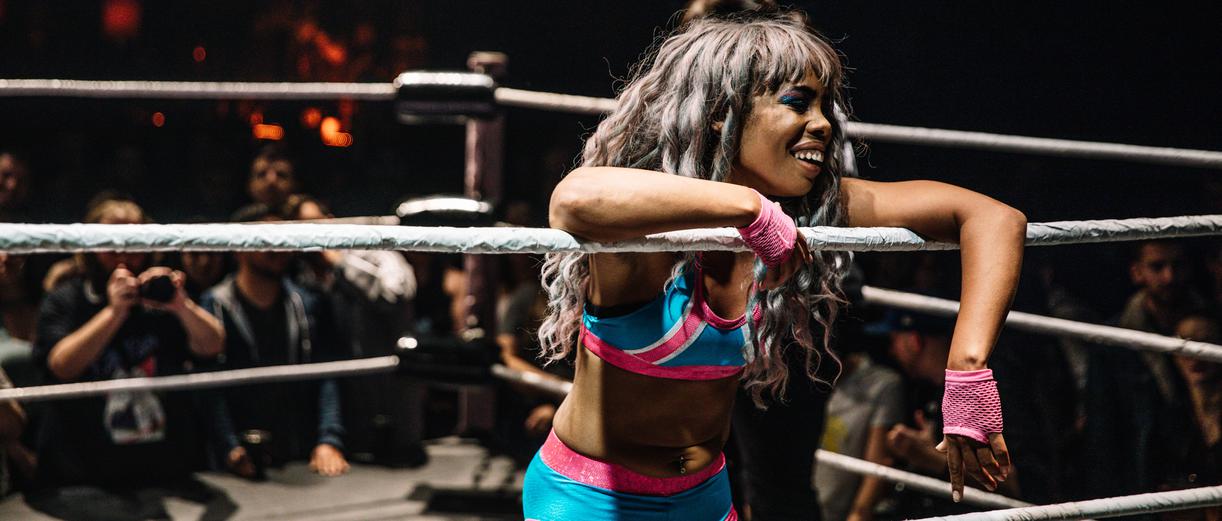
Tucked inside the Oakland Metro Operahouse is an event so unexpected yet so very Oakland: female-focused wrestling. Here's what it's like.
Even half an hour before the doors open, eclectic fans stand in line outside, energetically awaiting the moment they’ve looked forward to all week. As you might expect in Oakland, the crowd is dotted with all types of people. From someone with a partially shaved head and pink hair, to an adrogenous fellow with beautiful makeup and overalls, to a blonde in a Cheshire cat shirt, to a woman easily in her 70s, to a bro in an A’s hat, it strikes you first that everyone is welcome—just as they are.
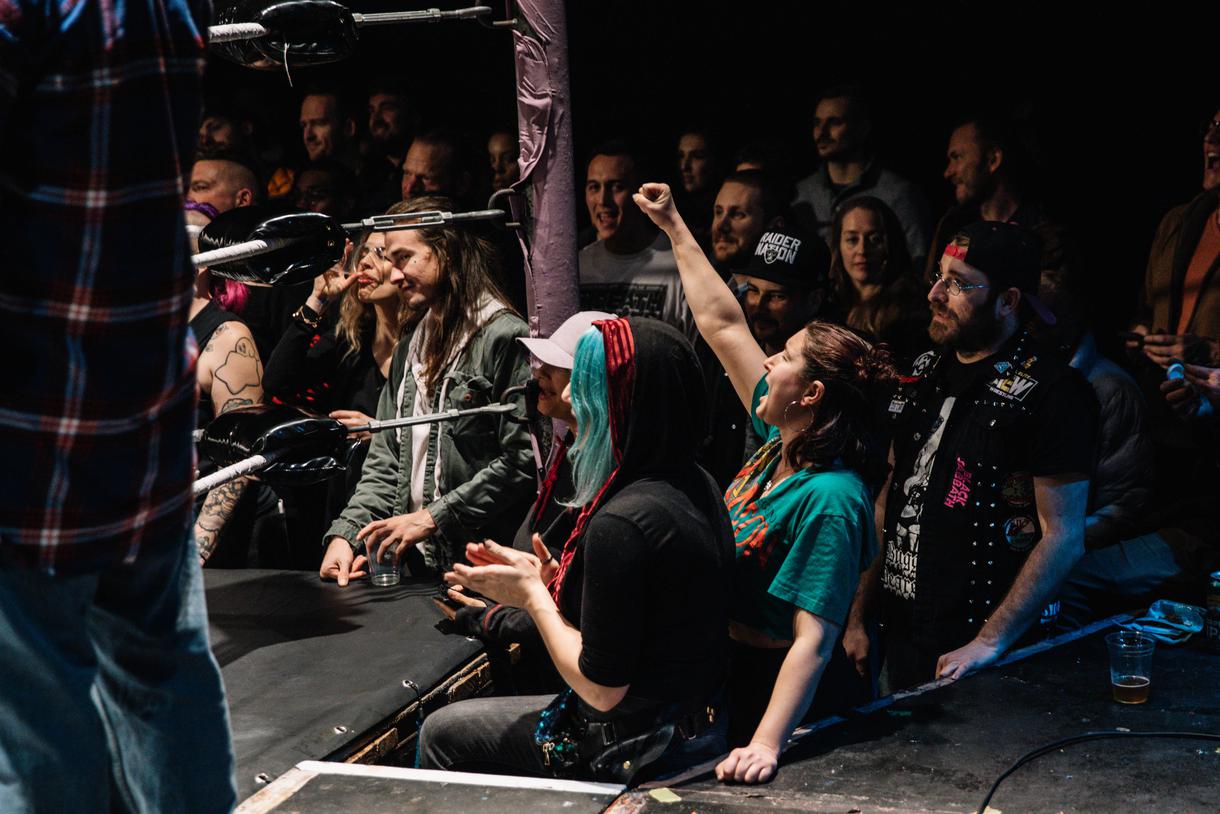
Tucked inside the Oakland Metro Operahouse, near the heart of Jack London Square, is an event so unexpected yet so incredibly Oakland: female-focused wrestling. Guilty Lethal Action Mayhem (better known as GLAM) is the badass athletic entertainment of your dreams. Complete with intricate backstories, impressive physicality, and a plethora of showmanship, GLAM has something for everyone. And in a world that seems increasingly divided, it’s refreshing to see such a diverse group of individuals come together.
Before attending my first wrestling show—which happened to fall on GLAM’s one-year anniversary—I sat down with GLAM manager, Anton Voorhees, to talk about wrestling, Oakland, and what it takes to host the events.

Does your business rank among the best in California?
nominate a businessLearn more about our selection criteria and vetting process.
Q&A with GLAM Manager: Anton Voorhees
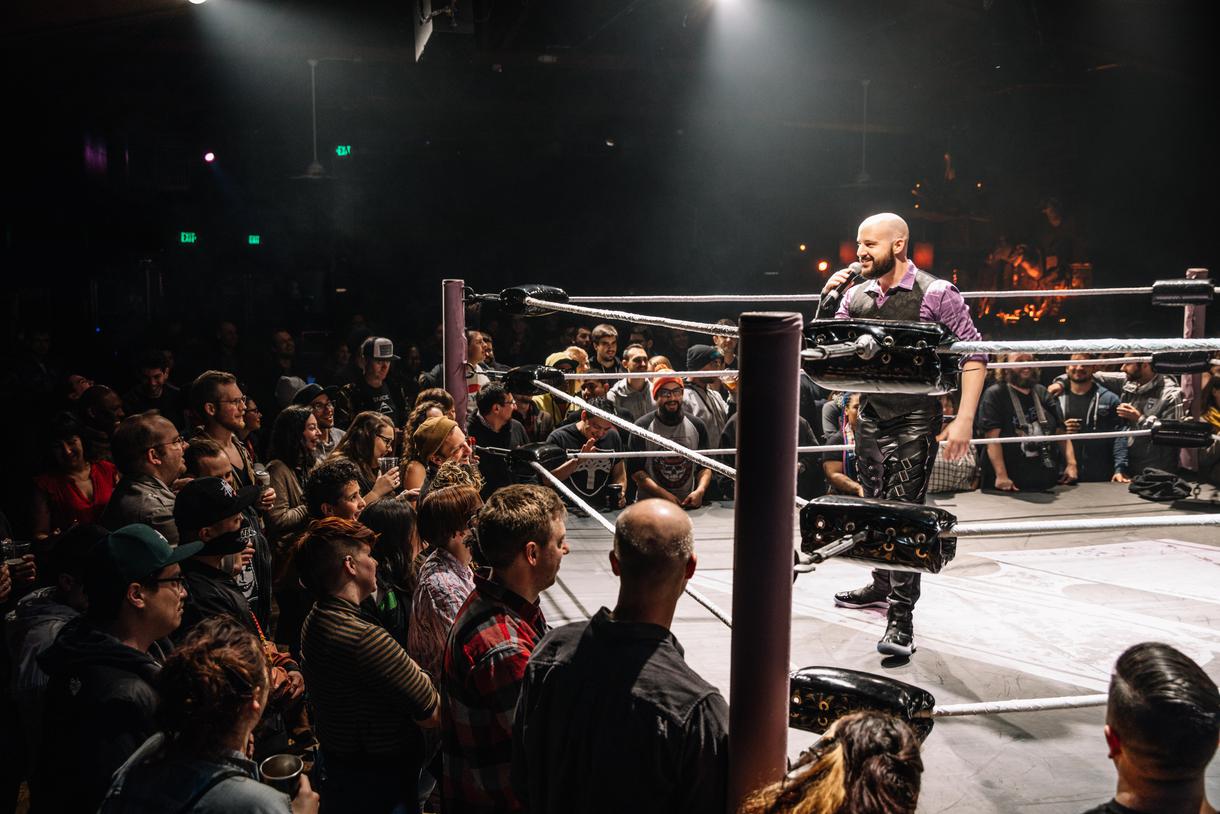
A: One of my friends [Sam] started Hoodslam and asked me if I wanted to be involved. The venue itself asked us in 2017 if we would consider doing it every week instead of once per month. Sam didn’t want to be in charge of doing shows every single week and had the idea of coming up with a women-focused wrestling company under the umbrella of Hoodslam and asked me if I wanted to take charge of it. I said sure, and here we are now.
If you have preconceived notions of wrestling and you don’t like it, you can still give Hoodslam and GLAM a chance because they’re not whatever you think professional wrestling is.
A: I want to say that it was kind of easy. It was an idea that, when Sam brought it up, was like, Yeah, this is going to work, there’s no women’s wrestling company around here. So, [I knew] it was going to work, but I never saw myself in the position that I am now—being in charge of a company and figuring out who’s going to be there and all that.
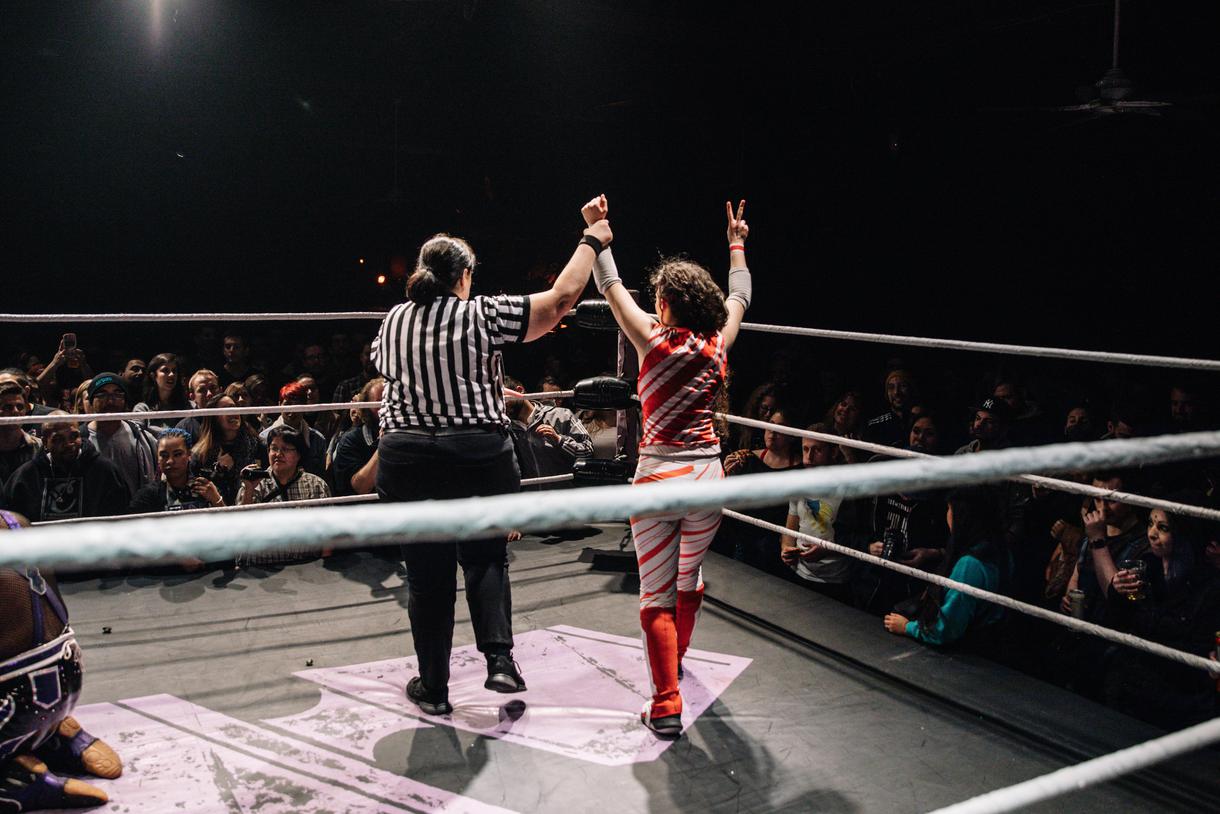
I like the vibe of Oakland. It’s a fun and exciting environment and it’s such an eclectic grouping of human beings. … That’s what Oakland is to me: creativity. It’s this place where people have migrated to, to be who they are.
A: I feel like in women’s wrestling, they’re struggling to be seen as equal to men’s wrestling, because too many times some guy in the back will be like, “That was good for a girls’ match”, and that’s a really backhanded thing to say.
My biggest concern was: I don’t want to run a wrestling show like a wrestling show. I want it to be this potpourri of entertainment that’s not just like, “Well I don’t like wrestling”. Even if you don’t like wrestling, you might still like GLAM because it’s a show more than it is a wrestling show. My concern was that girls would be wanting to do a serious wrestling show, and I have asked them to do silly things.
In the very beginning, we were going to have a tournament, and it wasn’t for any reason; it was because we didn’t have enough people at the show. And we thought, If we have a tournament, they’ll have to wrestle more than once, and it’ll seem like a longer show.
I had to make up what this tournament was for, and I was making it up on the fly, so I was like “This is for a key”. And they’re like, “What’s the key do?” And I was like, “Well, I don’t know yet”. And then the next show I was like “Alright, the key opens a door, but you need two keys, so now we have to have another tournament for the second key”. And it was just silly things because girls were fighting for keys that they didn’t know what they did. Then, [the keys] end up opening a door to a different dimension, and we still have yet to say what’s over there—we just know that someone’s come out and they had magic powers. These are the silly things I’ve asked girls to do, and they’ve all been on board.
They come because it’s fun, which is ultimately all I want. I don’t want them to come and try to prove something—they have nothing to prove, they’re all really talented.
A: I like to compare it to swing dancing. You’ve practiced how to swing dance—you’ve gone to classes and gotten good at it—but then you went to a wedding and some person was like, “Do you know how to swing dance?” And you’re like, “Yeah”, and you guys do it. People are constantly practicing, and most wrestlers still go to training, but they’re not practicing with the person they’re going to wrestle. On the day of the show, you meet up and talk about what you’re thinking about doing, and we’ll see you in the ring.

A: The first show, I had no plans to do doors to other dimensions. I was just going to have a women-focused wrestling show. I think a lot of people expected it to be a women-only wrestling show, but that was never our plan. We always wanted it to be a women’s wrestling show with some men instead of a men's wrestling show with some women, if any. I wanted to turn it on its head—not to have an exclusive girls-only type of club. That perception has been the biggest change people have accepted. Building the stories to the point where fans can accept that I don’t like her, but she can wrestle this guy and I don’t immediately want him to die—I can be on his side.
Luckily, [the wrestling industry is] becoming a much more inclusive environment. We’ve been very lucky to have [the show] in Oakland—which has been a very accepting place—and we have the entire spectrum on our roster and in our crowd. Wrestling is slowly becoming more progressive, and we are trying to be at the forefront of that.
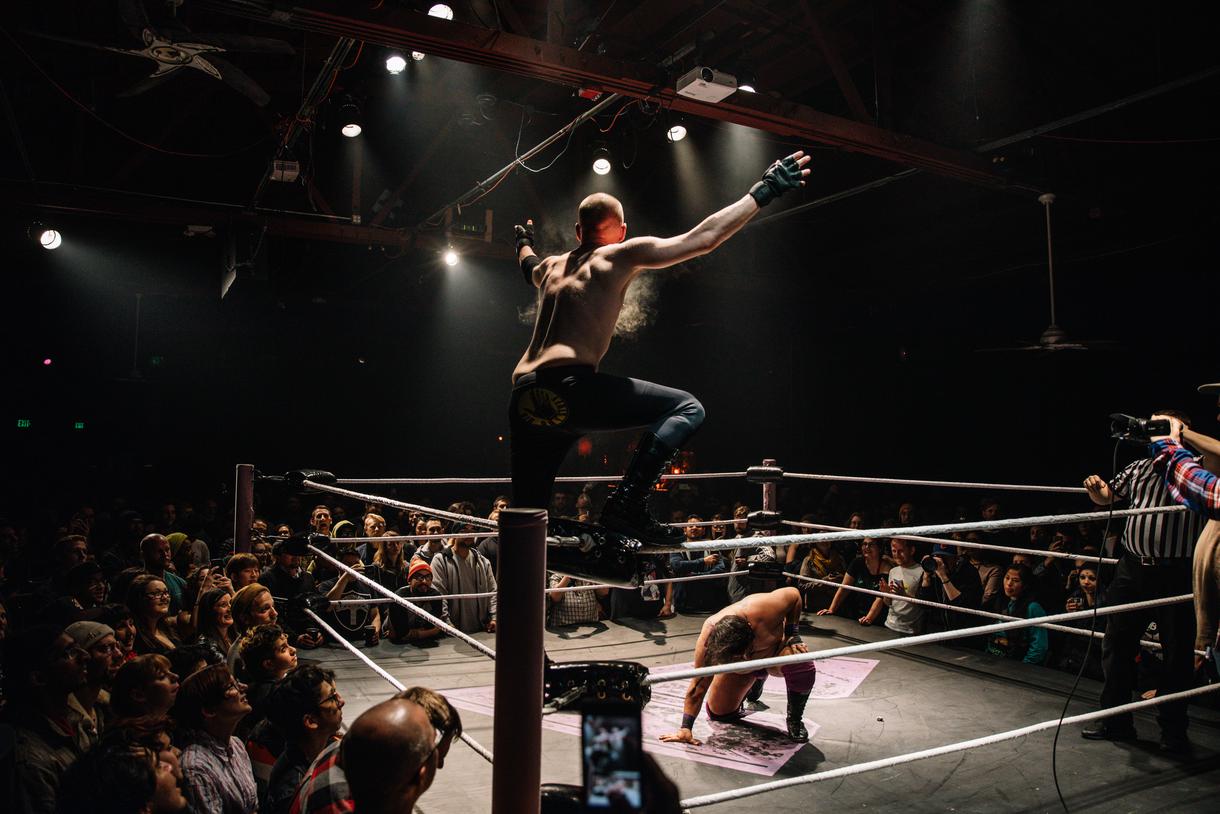
A: The bad thing about wrestling is that it’s always had people in the crowd that want to be part of the show. So, they will try to shout awful things to get a laugh or whatever. And I always tell people when I was training them to be wrestlers that you have to have thick skin, because someone in the audience is going to say the worst thing that they can to you, and that’s something you’re going to have to get over.
But I think at this point, the vast majority of wrestling fans are over it. They’re not here to only see beautiful people wrestling beautiful people or fitness models. I think for women’s wrestling, it is a little harder. I think that there’s going to be a good amount of people that only want to see pretty people, but that’s never been what we base anything off of.
Our roster is a bunch of attractive women, but it’s not deliberate;it’s just seeing who wants to come and wrestle for us. I think we’ve been blessed with the diverse roster that we have, but I don’t think that if our roster was any different anyone would be like, “That person can’t wrestle here; we don’t want to see this.” They’re just there to have a good time.

A: For a while, it was me coming up with them after the fact. It was really a train of thought of, Well, here’s where we are. Where do we go next?
It was difficult at times because I had two major storylines throughout the year. I wanted to do this big thing, but we started it and the next show three people couldn’t come, so we had to scrap that idea. Then, I came up with another big idea, and a couple of people couldn’t come. So I thought, I should just focus on show per show instead of trying to figure it all out.
But I am now, at this show, starting a story that hopefully will develop, and it’s not just going to be at GLAM; it’s going to travel back and forth between GLAM and Hoodslam for the first time. Hopefully nobody drops out of this one, but as independent contractors, each individual wrestler is trying to do what makes them most satisfied, so I try to be as understanding as possible.
A: I’m hoping that we can get GLAM to travel and go to other venues. It would be cool to see if other places apart from Oakland would be interested in seeing our show.
But mostly what I would like to do is grow our core audience. As an independent wrestling show, our numbers are great, but when you compare it to Hoodslam on the first Friday [of the month], we’re getting 600 to 900 people. But the next week at GLAM, we’re getting 200 to 300—which is still a lot of people, but when you compare it to the week before, [you start to wonder], Why didn’t those people come back?
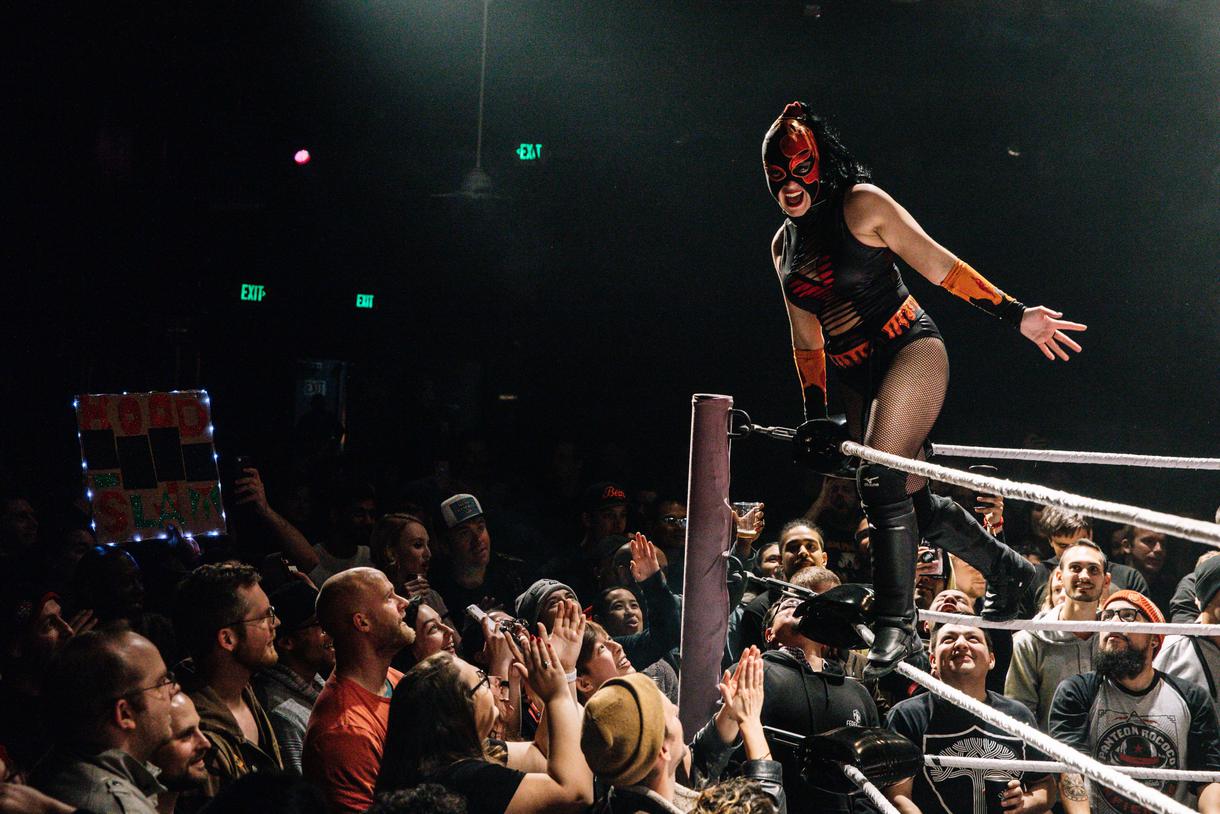
A: Expect there to be a lot of people that are there to have a good time. That’s my favorite part about our GLAM audiences; they’re not necessarily there to see a wrestling show, they’re there to just see something and have a good time. Expect there to be some craziness going on.
We don’t have chairs—it’s standing room only—people are literally surrounding the ring, leaning up against it at times, so understand that it’s more of a concert environment than it is sitting down and watching theater. You’re in the mix. You’re involved. It’s a good time. It’s not what I grew up watching wrestling as, but I think it’s a lot more fun, so expect to have a good time.
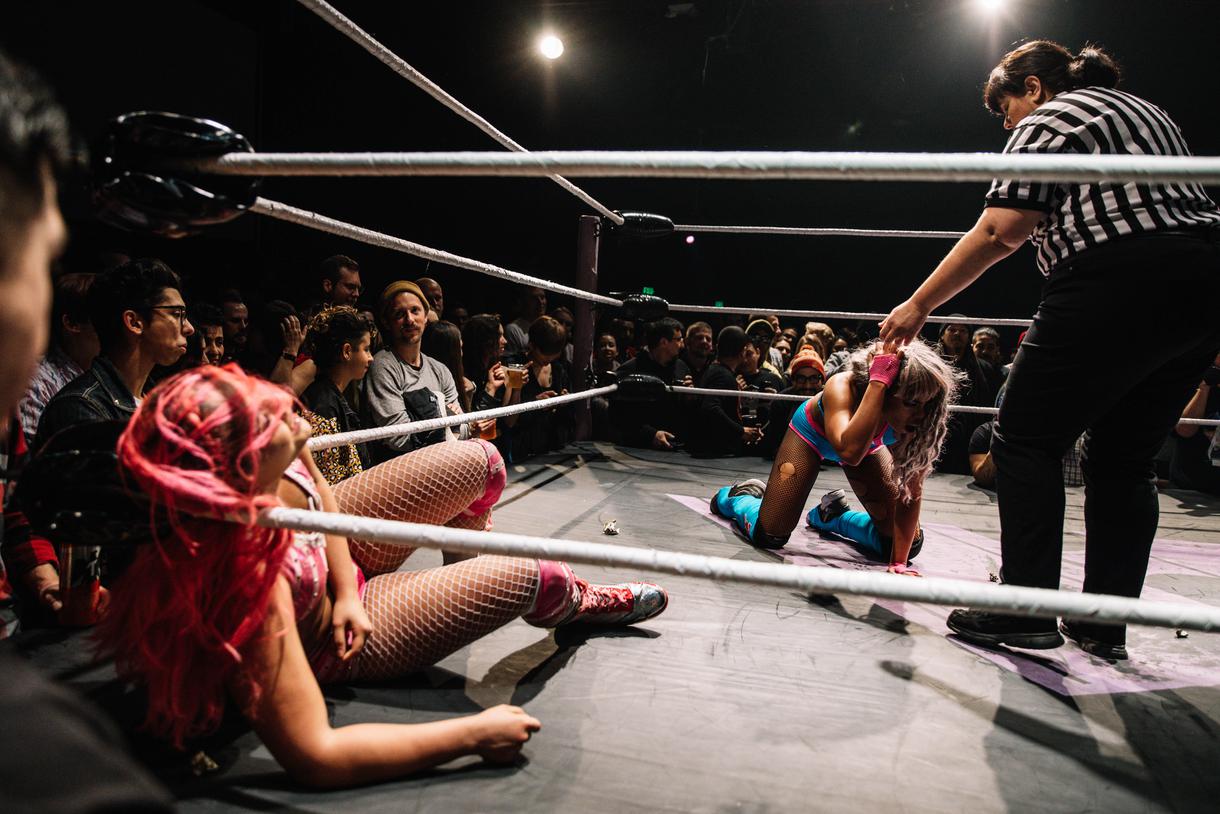
Even with his Voorhees’ insights, I was not prepared for what was in store.
Entering the nearly empty Oakland Metro Operahouse while the performers were still getting ready was somewhat of a surreal experience. After our IDs were checked, we were sent to the back where the ring was set up and the wrestlers were discussing their ideas for the evening. So this is how it happens, I thought, marveling at their ability to improvise something that completely captivates audiences.
Trying not to stare at the performers, I made my way to the restroom before the hoards of people were invited through the doors. Thinking I had steered clear of any awkward encounters, I was surprised to nearly bump elbows with “Ultra Girl” Brittany Wonder at the sink. Feeling something akin to starstruck, I made my way back out, toward the ring, and secured a front-row spot to take it all in.
Soon after, the crowds began to enter, filling the empty room and making it seem significantly larger than it had just moments before. The energy in the room was palpable as the show drew near; the audience was filled with all kinds of humans, who were brought together regardless of gender identity, age, style, or any other divisive factor—resulting in a contagious excitement for life and for wrestling.
As someone who had only watched a few episodes of GLOW on Netflix, my knowledge of anything wrestling-related was essentially nonexistent. But thanks to my years of theater experience, the acting component hit much closer to home. Though I had feared sticking out in a crowd of hardcore enthusiasts (which I did, particularly when everyone around me was chanting, “This is real”), the welcoming crowd invited me into their world. The regulars seemed excited to have new viewers join in, banishing all my worries about being an outsider among an intense group of fans.
The show began with Voohees’ ode to former co-host Kathy Campanelli as all tributes should—with a belted rendition of “Ain’t No Sunshine”. While unexpected, this introduction eased us in and made us feel comfortable in a foreign environment. Then Killer Bae, a.k.a. Heather Monroe, commanded the stage as she took her seat next to Voorhees as GLAM’s new co-host. But as soon as Simone Sherie and “Ultra Girl” Brittany Wonder stepped into the ring, a wave of joy and passion overwhelmed the audience, plastering smiles on my group’s faces that remained there until the end.

There was something unique and special about every one of the performers that made each match seem novel. The bouts—which were called by referees Nuk Nuk Johnson, Wiggles, and Karina Kyle—went as follows (with the winner of each match stated first):
1. 'Ultra Girl' Brittany Wonder vs. Simone Sherie
2. DARK Sheik vs. Vulcana Pro Wrestler
3. Mazzerati - Shay the Fox Mazzato vs. Danika Della Rouge
4. Brutal Rob Hands vs. Thicc Martel
5. Aleyah Mia Garcia vs. Vipress with Saint Synclair
6. Da Squaaad’s D-Rogue vs. Tia Mott
7. Da Squaaad’s Hip Hop Harry and The Kenny K. with special guest D-Rogue vs. Side Pony Homie Fidel Bravo and Leslie Iris
The hours passed quickly as DARK Sheik’s commanding presence; Vulcana’s showmanship; Brutal Rob Hands’ inflated ego; Vipress and Saint Synclair’s dynamism; Hip Hop Harry’s athleticism; Aleyah Mia Garcia’s wholesome vibe; Tia Mott’s fearlessness; and Mazzerati’s fiery spirit filled every inch of the theater.
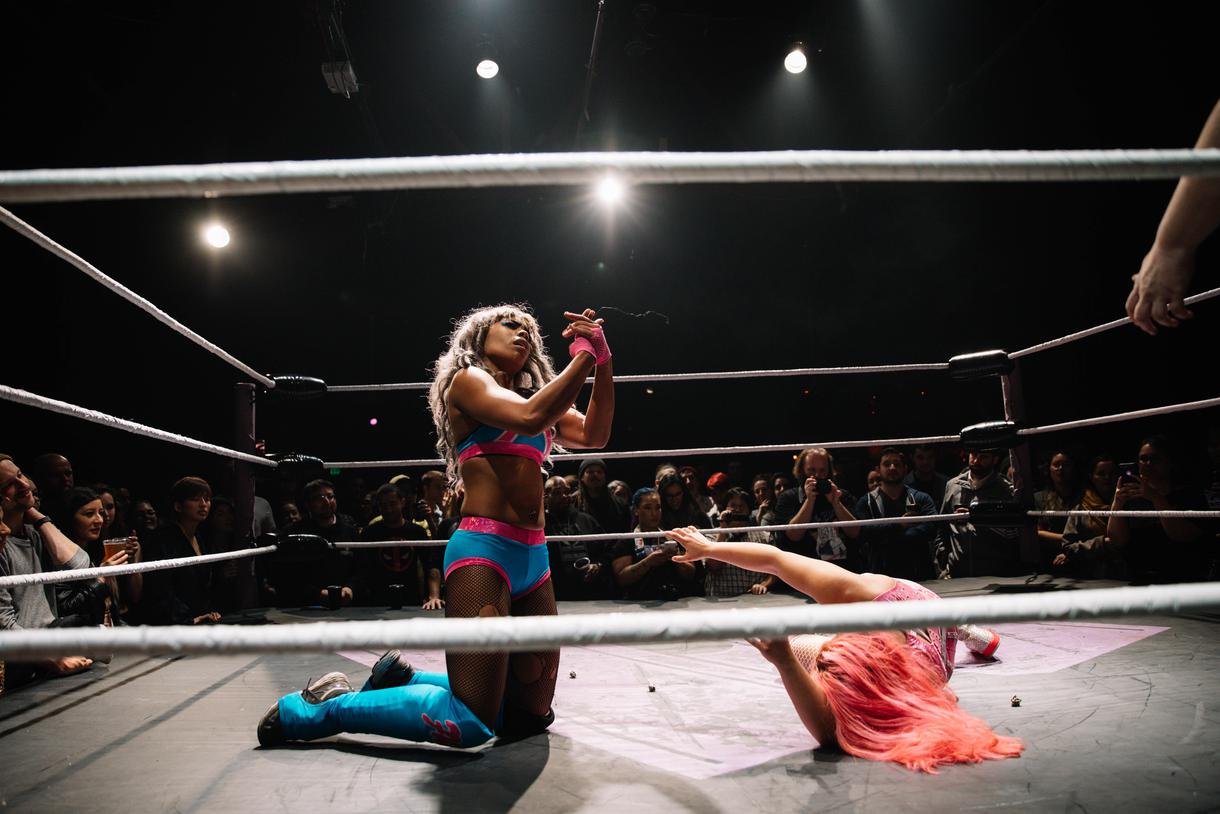
As incredible as the wrestlers are individually, the most impressive element of GLAM is their ability to make it seem as though anyone could join them onstage. To enhance this inclusivity, the performers are incredibly supportive of their fellow wrestlers—joining the crowd after their own matches, cheering their friends on, and genuinely having a great time.
Once I’d spent a few hours immersed in their universe, I felt quite at home—and honestly hadn’t smiled that much in a very long time. Though my back began to ache from the time spent standing on hard floors, the mild discomfort was far outpaced by the enjoyment I had while getting swept up in the storytelling.
After the show, I caught up with Sam Khandaghabadi (also known as DARK Sheik), to get a better understanding of the world of wrestling, how she dreamt up GLAM, and the journey she’s taken to get here.

A: I lived in Atlanta until I was about 13. My father got a job out here, so we moved; we got a U-Haul and drove across the country. He was just looking at this job and I was like, “Okay”. Then two months later he was like, “We move Friday.” I didn’t really take him seriously.
It didn’t really click with me until I was like, Oh, we’re filling all my stuff in a U-Haul and getting out of here. I moved originally to Albany, California, which is a suburb right next to Berkeley. It’s a one-mile town with a very nice image and a horrible underneath if you ask me. I like Oakland better. I’ve been there since I graduated high school, and it’s really been home for me. It’s the first place I went to that felt like home.
A: The people. It’s a weird balance between community and anonymity. In Los Angeles or Brooklyn, no one knows who I am. I can just walk into any pool of people and just blend right in. I can’t do that in every state. I can kind of do that a lot in Oakland too, but people know each other here.
A: I was trying to get ahead in the wrestling world, but I kind of saw that the world around me wasn’t what I wanted to be a part of. The way they were doing it wasn’t how I wanted to see it done—it wasn’t very fulfilling. I try to do something more for my friends, a show where they could be seen, that would be fun, and that was done the right way.

A: (Laughing) It’s super easy; I barely work. An average show day is mostly me playing on my phone and organizing through there, sending emails, and keeping the Eventbrite updated. Anton does a lot with GLAM, to be fair; he pretty much runs it. I’m mostly reaching people and making sure they know what’s going on—it’s just a ton of tiny things like getting the flyer done, making sure it gets to the print shop, making sure our Facebook ads got approved, ensuring we have all the right music, making sure the venue knows we’re coming (which is something to think about sometimes), making sure we have insurance.
It’s a million two-minute things and five-minute things. There’s a lot of moving parts, but it’s really about communication more than anything.
A: It’s been amazing! It’s like a dream come true. Not only am I able to present what I want on a bigger scale, but my friends are being seen by a bigger audience. And it’s rewarding for the venue, too—I like that because they’re also my friends. It’s very fulfilling and rewarding.
A: God, no. No. I wrestled for about 10 years before I started Hoodslam, and I told people: “I will never be a business owner. It seems like way too much work. It seems like such a headache. I just enjoy performing, and the business side is going to kill it for me.” I was half right.

A: I think that’s fair. As I have, too. It started because my trainers were like, “You’re Iranian, so you have to be a sheik; you have to be a Middle Eastern character because you speak the language.”
I didn’t really like that because I thought I’d seen it done to death, and it just seemed like such a stereotypical, negative thing. But it’s what I became known as. So when Hoodslam began, I decided to do something called DARK Sheik, which would be less Islamic and more mystic, or Pagan.
Now, it’s very much an extension of my personality—it’s more me than it’s ever been. I still like having separation between myself and my character, but they’ve never been so in-tune.
It used to be more of an angry and aggressive character. It was built a lot around the resentment of being an Iranian in this country. I was performing as DARK Sheik during the height of the Iraq and Afghanistan invasions, and it was ugly; people would say things, people would threaten me or send me emails, follow me after the show and try and fight me—all these kinds of things.
Eventually, people stopped though, and I kind of softened up, too. I started having a lot more fun performing, as opposed to trying to portray this villain that people wanted me to be.
A: Myself. Fear and insecurity—because I wrestled as a man for 19 years. This last year, I’ve been myself for the first time. I thought I was going to have to stop performing, but I’ve been able to overcome myself, and I feel like I have a connection with people now more than ever. Probably because I’m being my own authentic self more than ever.
I had been one thing for so long that I thought if I became something new, new audiences wouldn’t take to it, and old audiences would feel betrayed. It’s kind of like in life with transitioning. At first, I was afraid that people I’d known forever would think that I was lying to them this whole time or being dishonest about who I really am—which isn’t the case, but it just took me a long time to get where I am. I was just ignorant myself. But now, the comments I get that are positive outweigh all the negative.
On stage, I am very confident, because if anyone isn’t happy with me, just watch. Give it a couple minutes. You’re going to be very thrilled with me whether you like it or not.
A: People think we’re trying to insult their intelligence. Hoodslam has pushed really hard against that, and we use the phrase, “This is real”, and it’s more tongue-in-cheek. This is really happening; it’s a very real thing, but we’re not trying to fool you and make you think that Bugs Bunny is really a rabbit.
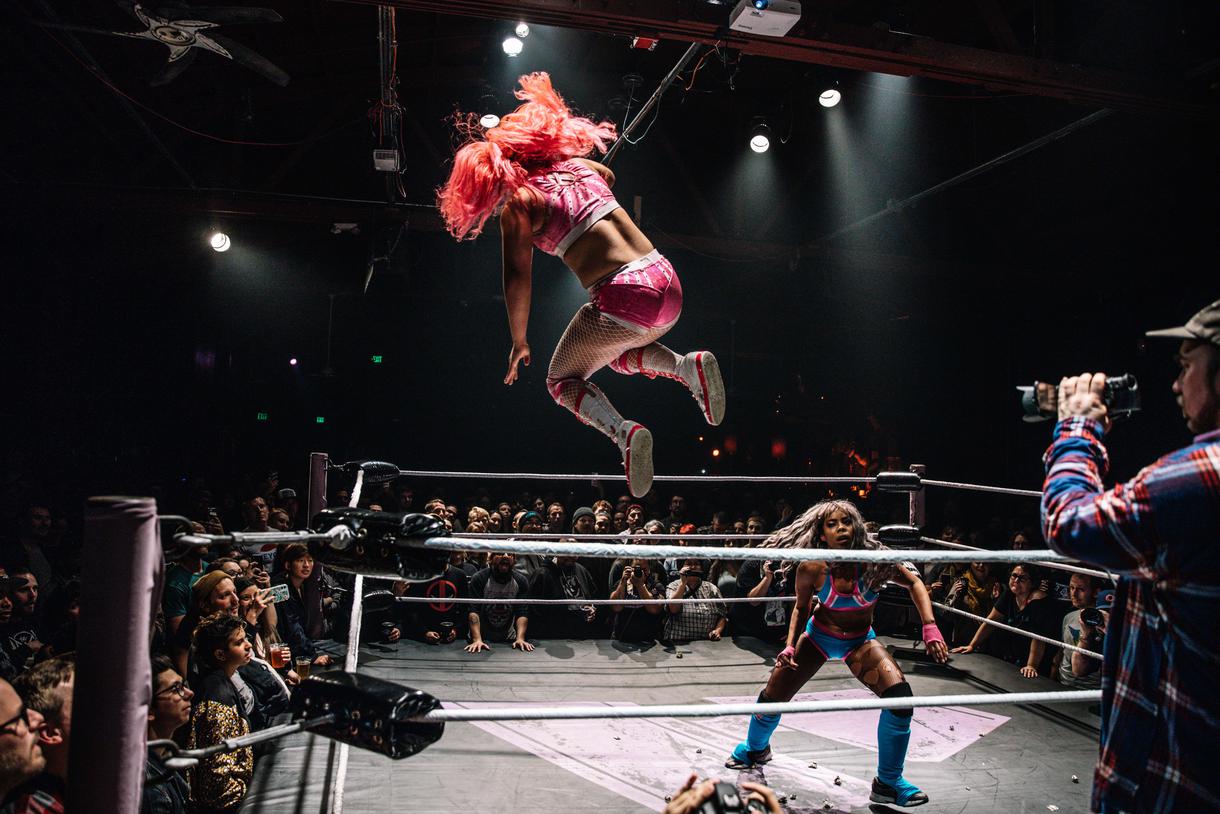
With women’s wrestling, people see GLOW and think everything is GLOW. It’s great because GLOW has inspired a lot of people to appreciate wrestling in a new way, but not everything is so dramatic. A lot of these people are just people that liked wrestling, too, and they got into it because they love it and they love performing now. They’re not out-of-work actors or ex-dancers—some of them do these things, too, but they’re there to wrestle.
They don’t also wrestle or do this, too; they live this. The roster at GLAM is the most hard-hitting group I’ve really been a part of. I get hurt all the time from these girls; they’re beating me up left and right.
A: The freedom it allows. And also, it’s a hybrid of so many different forms of entertainment—which ties into freedom. You could do gymnastics or martial arts or perhaps some kind of stage combat, but it wouldn’t be as fun. I could get on stage and play with swords; it would still be physically demanding, but it wouldn’t be this beautiful hybrid. It’s a fight scene with improvised dialogue, call and response, like theater in the round, but they clap not just at the end of the scene, but throughout. It’s much more fulfilling as a performer.
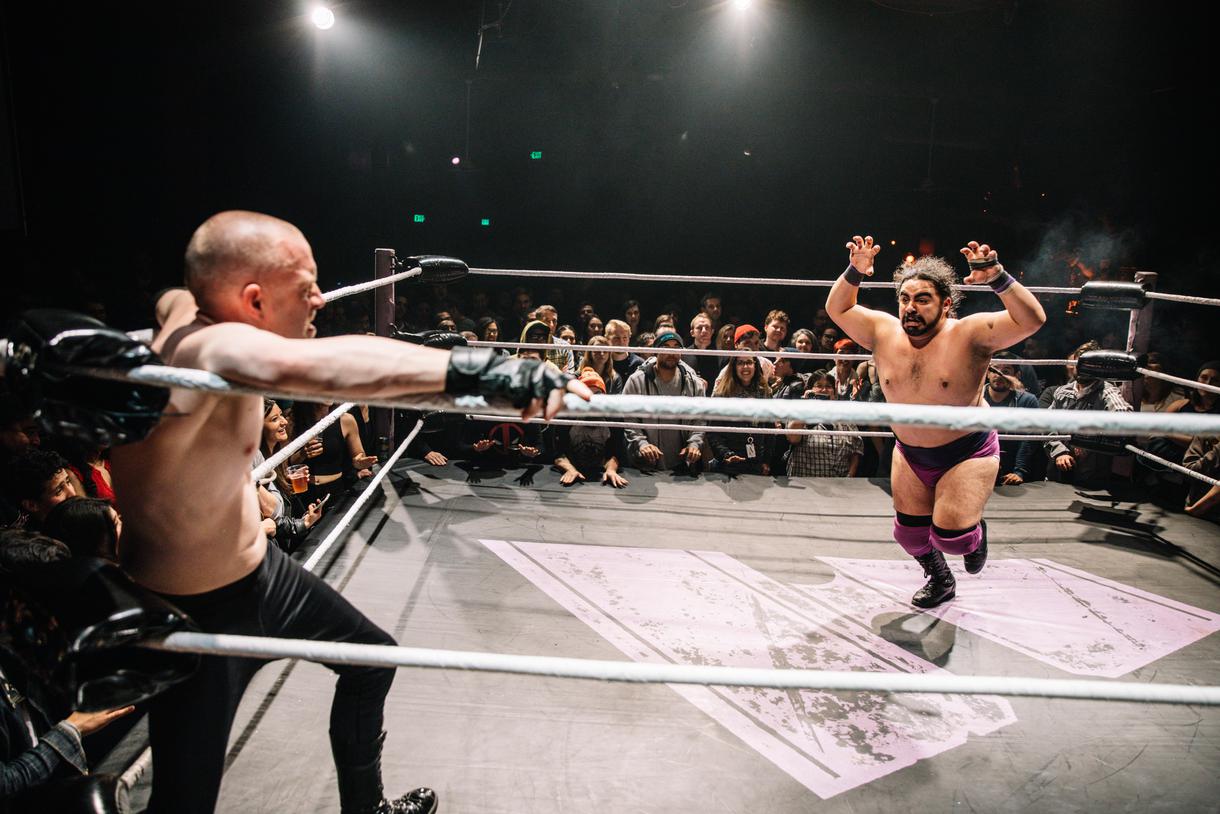
A: I try to stretch. I’ve been going to the Planetarium a lot. I’m trying to enjoy my life these days and grow, because it’s something I feel has been stagnant.
But any burrito truck is home to me. I play video games, I read X-Men comics, I sometimes train—occasionally—and try to have a social life. Vacuum—that’s something I’m not doing but should be doing.
I just try to be a human being. Nothing too exciting. I do get to do interviews and photoshoots, which is tied into the wrestling, but it’s new and I’ve really enjoyed it. And I like to go to concerts, see live performances, and comedians. There are so many people in The Bay who are contortionists, do aerial or suspension, do circus sideshows, or play music—so I try to go to as many of those as I can.
If wrestling is not your cup of tea, that’s okay. But I implore you to find some other type of local live entertainment that is for you and to support it. Even small [amounts of] support goes so far for an independent artist—even if it’s just a casual interaction of, “Hey, I don’t have money for a shirt, but I really enjoyed your performance.” It would mean the world to us, and I think that it would help whoever you are, too, by seeing the things you like.
If you haven’t been to GLAM yet, it’s time to start planning your trip to Oakland and give this unique opportunity a chance.


Never been before? We’ll be your trustee Little Tokyo guide with a day’s worth of fun things to do in Little Tokyo.
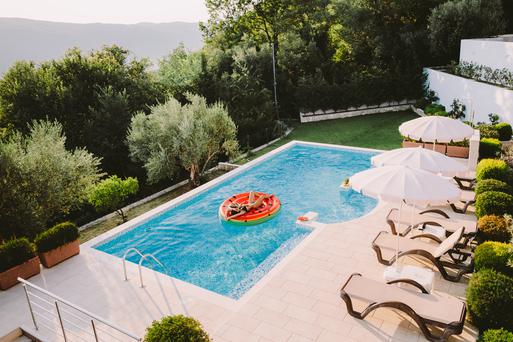
People go on Memorial Day weekend getaways as an indirect celebration of life. How do you plan on celebrating the long weekend?

From undulating mountains, to coastal expanses, to verdant forests, here are some of the top spots for backpacking in California.
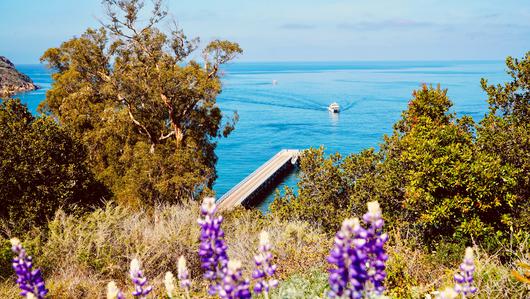
Settled off the California coast, the Channel Islands offer endless adventures. Here are the best things to do and how to get there.

